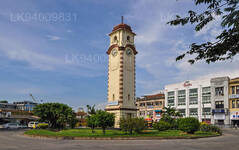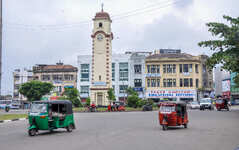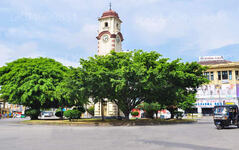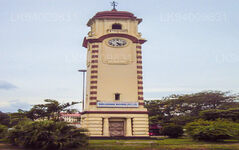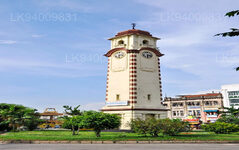
Città di Colombo
Colombo, la capitale dello Sri Lanka, è una città dinamica che fonde tradizione e modernità. Vanta un'architettura coloniale, vivaci mercati e sereni templi buddisti. Con una cucina variegata, uno skyline in continua crescita e splendide spiagge, è un vivace centro per gli affari, la cultura e il turismo, offrendo un punto di partenza ideale per esplorare le meraviglie dello Sri Lanka.
Khan Clock Tower
As you enter the City of Colombo from the Colombo Harbour, the first thing you would encounter is the sprawling Pettah Market. Filled with all the bright colors, noise, bustle, and pungent smells; the market is the biggest and busiest market on the island. All the goods that are brought in from the ships pass through the market, and as a result, you can find almost anything and everything here.
Guarding the entrance to this industrious zone is a century-old clock tower known as the Khan Clock Tower. The tower was built in the early 20th century by a Parsi family of the name Khan.
The Parsis were essentially Persians who had migrated to India around the 7th century AD for fear of religious discrimination when the Arabs invaded what is now Iran. Many settled in Gujarat. Their older roots segregated them from the modern Zoroastrian Indian community of Iranis who only arrived in the 19th and 20th century. The Parsis were often traders and had business interests in the nearby communities.
The Khan family were a particularly illustrious Parsi family who had many trade interests in Ceylon, as Sri Lanka was then called. They owned many large businesses, including the Colombo Oil Mills, which was quite famous at the time for producing many varieties of high quality oil.
In 1878, the patriarch of the family – Framjee Bhikhajee Khan – passed away leaving his two sons to take over the family’s trade. They successfully grew their businesses achieving fame and fortune over the next several decades. But they never forgot their father, who taught them so much and made them who they were.
In the year of 1923, they built a clock tower and fountain in his memory, close to where he loved to work. On the base of the clocktower an inscribed plate was attached. It said: "This clock tower and fountain was erected to the memory of Framjee Bhikhajee Khan by his sons Bhikhajee and Munchershaw Framjee Khan as a token of affectionate gratitude and dedicated through the Municipal Council to the citizens of Colombo on the fourth day of January 1923, the 45th anniversary of his death.”
The four-story tall tower remains there to this day on a landscaped roundabout. The water fountain that’s attached to it has long stopped working. But clock tower continues to function. A rock solid memorial to the love and affection of family.
Informazioni sul distretto di Colomb
Colombo è la città più grande e la capitale commerciale dello Sri Lanka. Si trova sulla costa occidentale dell'isola e adiacente a Sri Jayewardenepura Kotte, la capitale dello Sri Lanka. Colombo è una città vivace e trafficata, con un mix di vita moderna, edifici e rovine coloniali e una popolazione di 647.100 abitanti. La regione metropolitana di Colombo, definita dai distretti di Colombo, Gampaha e Kalutara, ha una popolazione stimata di 5.648.000 abitanti e si estende su una superficie di 3.694,20 km². Colombo è una città multietnica e multiculturale. È la città più popolosa dello Sri Lanka, con 642.163 abitanti che vivono entro i confini della città. La popolazione di Colombo è un mix di numerosi gruppi etnici, principalmente cingalesi, mori e tamil. In città vivono anche piccole comunità di persone di origine cinese, portoghese, olandese, malese e indiana, oltre a numerosi espatriati europei. La stragrande maggioranza delle aziende dello Sri Lanka ha sede a Colombo. Alcuni dei settori industriali includono prodotti chimici, tessili, vetro, cemento, pelletteria, arredamento e gioielleria. Nel centro città si trova il secondo edificio più alto dell'Asia meridionale: il World Trade Center.
Informazioni sulla provincia occidentale
La Provincia Occidentale è la provincia più densamente popolata dello Sri Lanka. Ospita la capitale legislativa Sri Jayawardenepura Kotte e Colombo, il centro amministrativo e commerciale della nazione. La Provincia Occidentale è divisa in 3 distretti principali: Colombo (642 km²), Gampaha (1.386,6 km²) e Kalutara (1.606 km²). Essendo il fulcro economico dello Sri Lanka, tutte le principali aziende locali e internazionali hanno sede in città, così come i principali negozi di stilisti e grandi magazzini, quindi preparatevi a concedervi un po' di shopping nella Provincia Occidentale. Avendo la popolazione più alta di tutte le province, quasi tutti i principali istituti scolastici dell'isola si trovano nella Provincia Occidentale. Le università della provincia includono l'Università di Colombo, l'Università di Sri Jayewardenepura, l'Università di Kelaniya, l'Università Aperta dello Sri Lanka, l'Università Buddista e Pali dello Sri Lanka, l'Università della Difesa Generale Sir John Kotelawala e l'Università di Moratuwa. La provincia occidentale ospita il maggior numero di scuole del paese, tra cui scuole nazionali, provinciali, private e internazionali.

